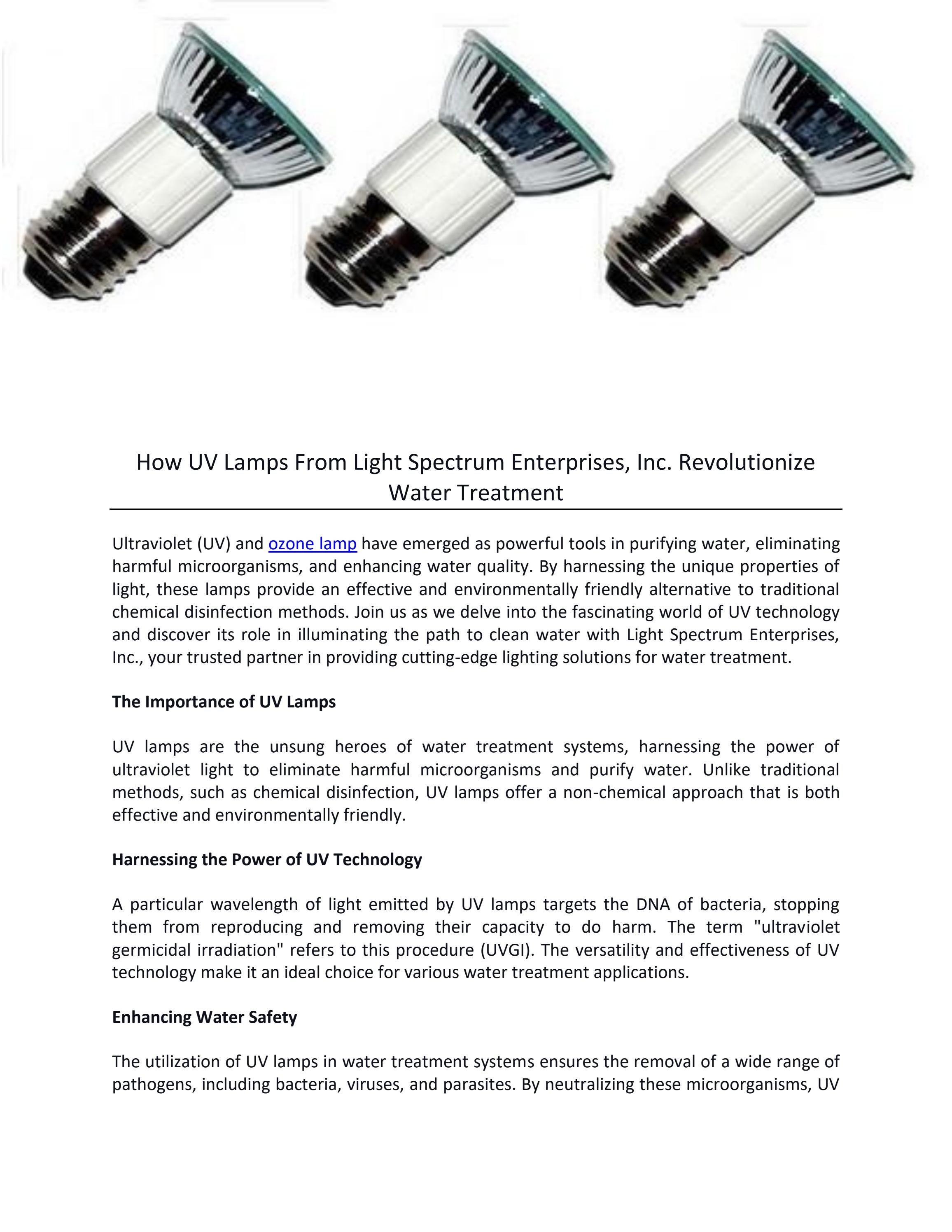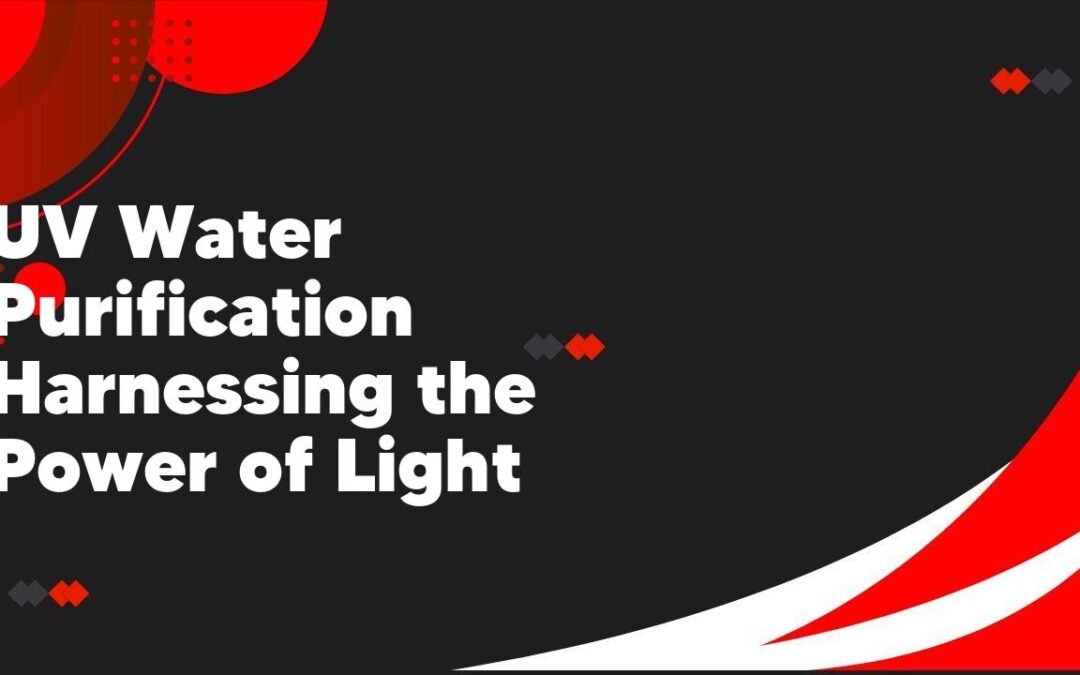In recent years, there has been a growing interest in using ultraviolet (UV) light for water purification. UV water purification harnesses the power of light to eliminate harmful bacteria, viruses, and other contaminants from drinking water. This article explores the benefits and drawbacks of UV water purification and its potential as a sustainable and effective solution for clean drinking water.
1. The Science Behind UV Water Purification
UV water purification is a highly effective and efficient process that harnesses the power of ultraviolet light to kill harmful microorganisms in water. As a microbiologist, I have always been fascinated by the science behind this technology. UV light, specifically in the range of 240-280 nm, damages the DNA of bacteria, viruses, and parasites, rendering them incapable of reproducing and causing disease. This process, known as germicidal irradiation, ensures that water is free from various pathogens that can cause illnesses such as cholera, typhoid, and dysentery. It is a safe and environmentally friendly method that does not involve the use of chemicals or produce harmful by-products. UV water purification is revolutionizing access to clean and safe drinking water, particularly in areas where traditional methods of water treatment are inaccessible or unaffordable.
2. Benefits of UV Water Purification for Safe Drinking Water

One of the benefits of UV water purification for safe drinking water is its effectiveness in killing harmful microorganisms. UV light has the ability to deactivate bacteria, viruses, and parasites present in water, making it safe for consumption. This method does not introduce any chemicals or additives to the water, which is an added advantage for those concerned about chemical contamination. Additionally, UV water purification is a quick and efficient process, making it ideal for those who need immediate access to safe drinking water. By utilizing UV technology, individuals can ensure that their water is free from harmful pathogens, providing peace of mind and promoting better overall health.
3. How UV Water Purification Systems Work
UV water purification systems work by utilizing ultraviolet light to kill harmful microorganisms in water. These systems are equipped with a UV light bulb that emits a high intensity of UV-C light. When water passes through the purifier, it is exposed to this light, which penetrates the cell walls of bacteria, viruses, and other pathogens. This exposure disrupts their DNA, rendering them unable to reproduce and causing them to die off. UV water purification systems are particularly effective in eliminating harmful bacteria like E. coli and Salmonella, as well as viruses such as Hepatitis and Rotavirus. It is a chemical-free method of water disinfection, making it safe and environmentally friendly.
4. Choosing the Right UV Water Purification System for Your Home
When it comes to choosing the right UV water purification system for your home, there are a few factors that you need to consider. Firstly, you should assess the size of your household and the amount of water you consume on a daily basis. This will help determine the capacity of the UV water purifier you should invest in. Additionally, it is important to look for a system that is easy to install and maintain. Nobody wants to spend hours trying to set up a complicated system or constantly worry about its upkeep. Lastly, don’t forget to check if the system you are considering is certified by a reputable organization. This will ensure that it meets the necessary quality and safety standards.
5. UV Water Purification vs. Other Water Treatment Methods
One of the most effective ways to purify water is through UV water purification. This method uses ultraviolet technology to kill and deactivate harmful bacteria, viruses, and other microorganisms that may be present in the water. Unlike other water treatment methods like boiling or chemical disinfection, UV purification does not alter the taste, odor, or color of the water. It is a chemical-free option that is safe and environmentally friendly. UV water purification is also easy to use and does not require any additional equipment apart from the UV lamp or system. Overall, UV water purification is a reliable and efficient method for ensuring the safety and cleanliness of the water we consume.
6. Common Misconceptions about UV Water Purification
When it comes to UV water purification, there are several common misconceptions that often lead to confusion among consumers. One of the biggest misconceptions is that UV water purification removes all impurities from the water. While UV treatment is highly effective in killing harmful bacteria and viruses, it does not remove other contaminants such as heavy metals, chemicals, and sediments. Another misconception is that UV water purification requires chemicals to be added to the water. In reality, UV treatment is a chemical-free process that utilizes ultraviolet light to kill microorganisms. Additionally, there is a misconception that UV purification is a slow process. However, UV systems are designed to provide fast and efficient purification, typically requiring just a few seconds of exposure to effectively eliminate harmful pathogens. It’s important to have a clear understanding of these misconceptions in order to make an informed decision about the most suitable water purification method for your needs.
Conclusion
In conclusion, UV water purification is a highly effective method for removing harmful bacteria and viruses from water. Its ability to harness the power of light allows for a chemical-free and eco-friendly approach to water treatment. With its increasing popularity and advancements in technology, UV water purification is likely to become even more widely used in the future.
What is UV water purification?
UV water purification is a process that uses ultraviolet light to disinfect water by eliminating harmful microorganisms such as bacteria, viruses, and fungi.
How does UV water purification work?
UV water purification works by exposing water to ultraviolet light, specifically UVC rays. The UVC rays penetrate the cells of microorganisms, damaging their DNA and preventing them from reproducing. This effectively neutralizes the microorganisms and makes the water safe to consume.
Is UV water purification effective?
Yes, UV water purification is highly effective in killing a wide range of harmful microorganisms, including bacteria, viruses, and parasites. It is a safe and reliable method of water disinfection when used correctly.
Does UV water purification remove chemicals from water?
No, UV water purification is primarily designed to kill microorganisms. It does not remove dissolved solids, chemicals, or heavy metals from water. If you are concerned about these contaminants, you may need additional water treatment methods such as activated carbon filtration or reverse osmosis.
Is UV water purification safe to use?
Yes, UV water purification is a safe and environmentally friendly method of water treatment. It does not require the use of chemicals, and it does not produce any harmful byproducts. However, it is important to follow the manufacturer’s instructions and regularly maintain the UV system to ensure its proper functioning.
Is UV water purification suitable for all water sources?
UV water purification is generally effective for treating most sources of clear and visually clean water, such as tap water, well water, and rainwater. However, it may not be as effective for treating turbid or cloudy water that contains high levels of sediment or organic matter. In such cases, pre-filtration or other water treatment methods may be required to improve the effectiveness of the UV purification system.

